Effects of Layer Thickness and Compaction Thickness on Green Part Density in Binder Jetting Additive Manufacturing of Silicon Carbide: Designed Experiments
Abstract
1. Introduction
2. Experimental Methods
2.1. Feedstock Powder
2.2. Binder Jetting of Green Parts
2.3. Design of Experiments
2.4. Green Part Density Measurement
3. Results and Discussion
3.1. Main Effect of Layer Thickness
3.2. Main Effect of Compaction Thickness
3.3. Interaction Effect of Layer Thickness and Compaction Thickness
4. Conclusions
- Both the layer thickness and compaction thickness exhibited significant effects on the green part density.
- The green part density was higher at the low level of layer thickness and at the high level of compaction thickness.
Author Contributions
Funding
Data Availability Statement
Acknowledgments
Conflicts of Interest
References
- Ngo, T.D.; Kashani, A.; Imbalzano, G.; Nguyen, K.T.; Hui, D. Additive manufacturing (3D printing): A review of materials, methods, applications and challenges. Compos. Part B Eng. 2018, 143, 172–196. [Google Scholar] [CrossRef]
- Sarila, V.; Koneru, H.P.; Pyatla, S.; Cheepu, M.; Kantumunchu, V.C.; Ramachandran, D. An Overview on 3D Printing of Ceramics Using Binder Jetting Process. Eng. Proc. 2024, 61, 44. [Google Scholar] [CrossRef]
- Chen, H.; Zhao, Y.F. Process parameters optimization for improving surface quality and manufacturing accuracy of binder jetting additive manufacturing process. Rapid Prototyp. J. 2016, 22, 527–538. [Google Scholar] [CrossRef]
- Moghadasi, M.; Miao, G.; Li, M.; Pei, Z.; Ma, C. Combining powder bed compaction and nanopowders to improve density in ceramic binder jetting additive manufacturing. Ceram. Int. 2021, 47, 35348–35355. [Google Scholar] [CrossRef]
- Doyle, M.; Agarwal, K.; Sealy, W.; Schull, K. Effect of layer thickness and orientation on mechanical behavior of binder jet stainless steel 420+ bronze parts. Procedia Manuf. 2015, 1, 251–262. [Google Scholar] [CrossRef]
- Moghadasi, M.; Du, W.; Li, M.; Pei, Z.; Ma, C. Ceramic binder jetting additive manufacturing: Effects of particle size on feedstock powder and final part properties. Ceram. Int. 2020, 46, 16966–16972. [Google Scholar] [CrossRef]
- Mao, Y.; Li, J.; Li, W.; Cai, D.; Wei, Q. Binder jetting additive manufacturing of 316L stainless-steel green parts with high strength and low binder content: Binder preparation and process optimization. J. Mater. Process. Technol. 2021, 291, 117020. [Google Scholar] [CrossRef]
- Mostafaei, A.; Elliott, A.M.; Barnes, J.E.; Li, F.; Tan, W.; Cramer, C.L.; Nandwana, P.; Chmielus, M. Binder jet 3D printing—Process parameters, materials, properties, modeling, and challenges. Prog. Mater. Sci. 2021, 119, 100707. [Google Scholar] [CrossRef]
- Ziaee, M.; Crane, N.B. Binder jetting: A review of process, materials, and methods. Addit. Manuf. 2019, 28, 781–801. [Google Scholar] [CrossRef]
- Li, M.; Du, W.; Elwany, A.; Pei, Z.; Ma, C. Metal binder jetting additive manufacturing: A literature review. J. Manuf. Sci. Eng. 2020, 142, 090801. [Google Scholar] [CrossRef]
- Du, W.; Ren, X.; Pei, Z.; Ma, C. Ceramic binder jetting additive manufacturing: A literature review on density. J. Manuf. Sci. Eng. 2020, 142, 040801. [Google Scholar] [CrossRef]
- Grady, J.E.; Halbig, M.C.; Singh, M. A fully non-metallic gas turbine engine enabled by additive manufacturing. In Proceedings of the International Symposium on Air Breathing Engines (ISABE 2015), Phoenix, AZ, USA, 25–30 October 2015. [Google Scholar]
- Lv, X.; Ye, F.; Cheng, L.; Fan, S.; Liu, Y. Fabrication of SiC whisker-reinforced SiC ceramic matrix composites based on 3D printing and chemical vapor infiltration technology. J. Eur. Ceram. Soc. 2019, 39, 3380–3386. [Google Scholar] [CrossRef]
- Thomas, J.; Banda, M.; Du, W.; Yu, W.; Chuang, A.; France, D.M.; Singh, D. Development of a silicon carbide ceramic based counter-flow heat exchanger by binder jetting and liquid silicon infiltration for concentrating solar power. Ceram. Int. 2022, 48, 22975–22984. [Google Scholar] [CrossRef]
- He, R.; Zhou, N.; Zhang, K.; Zhang, X.; Zhang, L.; Wang, W.; Fang, D. Progress and challenges towards additive manufacturing of SiC ceramic. J. Adv. Ceram. 2021, 10, 637–674. [Google Scholar] [CrossRef]
- Chen, W.; Chen, Z.; Chen, L.; Zhu, D.; Fu, Z. Optimization of printing parameters to achieve high-density 316L stainless steel manufactured by binder jet 3D printing. J. Mater. Eng. Perform. 2023, 32, 3602–3616. [Google Scholar] [CrossRef]
- Lecis, N.; Mariani, M.; Beltrami, R.; Emanuelli, L.; Casati, R.; Vedani, M.; Molinari, A. Effects of process parameters, debinding and sintering on the microstructure of 316L stainless steel produced by binder jetting. Mater. Sci. Eng. A 2021, 828, 142108. [Google Scholar] [CrossRef]
- Barthel, B.; Janas, F.; Wieland, S. Powder condition and spreading parameter impact on green and sintered density in metal binder jetting. Powder Metall. 2021, 64, 378–386. [Google Scholar] [CrossRef]
- Miyanaji, H.; Rahman, K.M.; Da, M.; Williams, C.B. Effect of fine powder particles on quality of binder jetting parts. Addit. Manuf. 2020, 36, 101587. [Google Scholar] [CrossRef]
- Jimenez, E.M.; Ding, D.; Su, L.; Joshi, A.R.; Singh, A.; Reeja-Jayan, B.; Beuth, J. Parametric analysis to quantify process input influence on the printed densities of binder jetted alumina ceramics. Addit. Manuf. 2019, 30, 100864. [Google Scholar] [CrossRef]
- Enneti, R.K.; Prough, K.C. Effect of binder saturation and powder layer thickness on the green strength of the binder jet 3D printing (BJ3DP) WC-12% Co powders. Int. J. Refract. Met. Hard Mater. 2019, 84, 104991. [Google Scholar] [CrossRef]
- Cheny, T.; Colin, C.; Verquin, B. Experimental evaluation of binder infiltration depth and axial overlap to control properties of green parts produced by Binder Jetting. Addit. Manuf. 2024, 87, 104231. [Google Scholar] [CrossRef]
- Meier, C.; Weissbach, R.; Weinberg, J.; Wall, W.A.; Hart, A.J. Critical influences of particle size and adhesion on the powder layer uniformity in metal additive manufacturing. J. Mater. Process. Technol. 2019, 266, 484–501. [Google Scholar] [CrossRef]
- Budding, A.; Vaneker, T.H. New strategies for powder compaction in powder-based rapid prototyping techniques. Procedia CIRP 2013, 6, 527–532. [Google Scholar] [CrossRef]
- Zhou, Z.; Mitchell, C.A.; Buchanan, F.J.; Dunne, N.J. Effects of Heat Treatment on the Mechanical and Degradation Properties of 3D-Printed Calcium-Sulphate-Based Scaffolds. Int. Sch. Res. Not. 2013, 2013, 750720. [Google Scholar] [CrossRef]
- Bredt, J.F.; Anderson, T.C.; Russell, D.B. Three Dimensional Printing Material System and Method. Google Patents US7087109B2, 8 August 2006. [Google Scholar]
- Vacanti, J.P.; Cima, L.G.; Cima, M.J. Vascularized Tissue Regeneration Matrices Formed by Solid Free Form Fabrication Techniques. Google Patents US6176874B1, 23 January 2001. [Google Scholar]
- Butscher, A.; Bohner, M.; Döbelin, N.; Galea, L.; Loeffel, O.; Müller, R. Moisture based three-dimensional printing of calcium phosphate structures for scaffold engineering. Acta Biomater. 2013, 9, 5369–5378. [Google Scholar] [CrossRef] [PubMed]
- Utela, B.; Storti, D.; Anderson, R.; Ganter, M. A review of process development steps for new material systems in three dimensional printing (3DP). J. Manuf. Process. 2008, 10, 96–104. [Google Scholar] [CrossRef]
- Shanjani, Y.; Toyserkani, E. Material Spreading and Compaction in Power-Based Solid Freeform Fabrication Methods: Mathematical Modeling; University of Texas Libraries: Austin, TX, USA, 2008. [Google Scholar] [CrossRef]
- Rishmawi, I.; Salarian, M.; Vlasea, M. Tailoring green and sintered density of pure iron parts using binder jetting additive manufacturing. Addit. Manuf. 2018, 24, 508–520. [Google Scholar] [CrossRef]
- Yoo, J. Fabrication and Microstructural Control of Advanced Ceramic Components by Three Dimensional Printing. Ph.D. Thesis, Massachusetts Institute of Technology, Cambridge, MA, USA, 1996. [Google Scholar]
- Yoo, J.; Cima, M.; Khanuja, S.; Sachs, E. Structural Ceramic Components by 3D Printing; University of Texas Libraries: Austin, TX, USA, 1993. [Google Scholar]
- Foteinopoulos, P.; Esnault, V.; Komineas, G.; Papacharalampopoulos, A.; Stavropoulos, P. Cement-based additive manufacturing: Experimental investigation of process quality. Int. J. Adv. Manuf. Technol. 2020, 106, 4815–4826. [Google Scholar] [CrossRef]
- Montgomery, D.C. Design and Analysis of Experiments; John Wiley & Sons: Hoboken, NJ, USA, 2017. [Google Scholar]
- Pei, Z.; Strasbaugh, A. Fine grinding of silicon wafers: Designed experiments. Int. J. Mach. Tools Manuf. 2002, 42, 395–404. [Google Scholar] [CrossRef]
- Rahman, T.T.; Arman, M.S.; Perez, V.; Xu, B.; Li, J. Analysis of the operating conditions of pulse electric field–assisted EHD for sodium alginate printing using design of experiment approach. Int. J. Adv. Manuf. Technol. 2021, 115, 2037–2047. [Google Scholar] [CrossRef]
- Yap, Y.L.; Wang, C.; Sing, S.L.; Dikshit, V.; Yeong, W.Y.; Wei, J. Material jetting additive manufacturing: An experimental study using designed metrological benchmarks. Precis. Eng. 2017, 50, 275–285. [Google Scholar] [CrossRef]
- DeVor, R.E. Statistical Quality Design and Control: Contemporary Concepts and Methods, 2nd ed.; Chang, T.-H., Sutherland, J.W., Eds.; Pearson/Prentice Hall: Upper Saddle River, NJ, USA, 2007. [Google Scholar]
- Dorula, M.; Khademitab, M.; Jamalkhani, M.; Mostafaei, A. Location dependency of green density and dimension variation in binder jetted parts. Int. J. Adv. Manuf. Technol. 2024, 132, 2853–2861. [Google Scholar] [CrossRef]
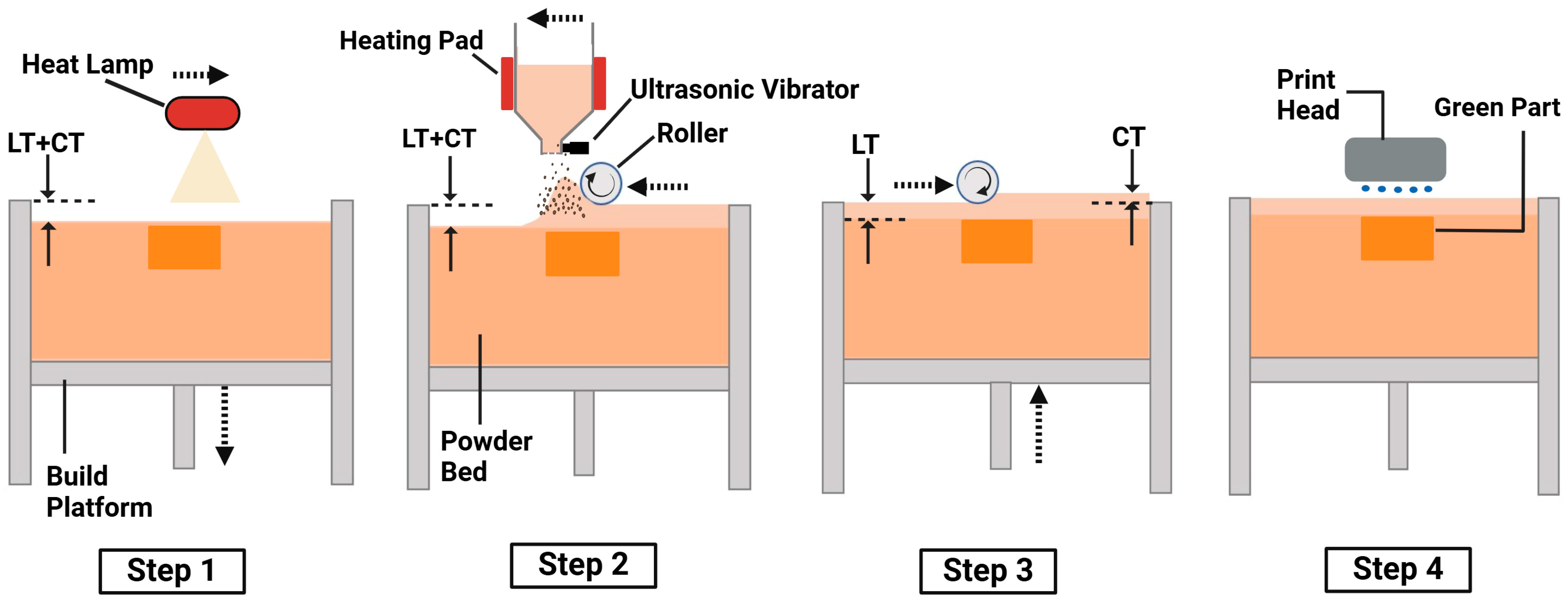
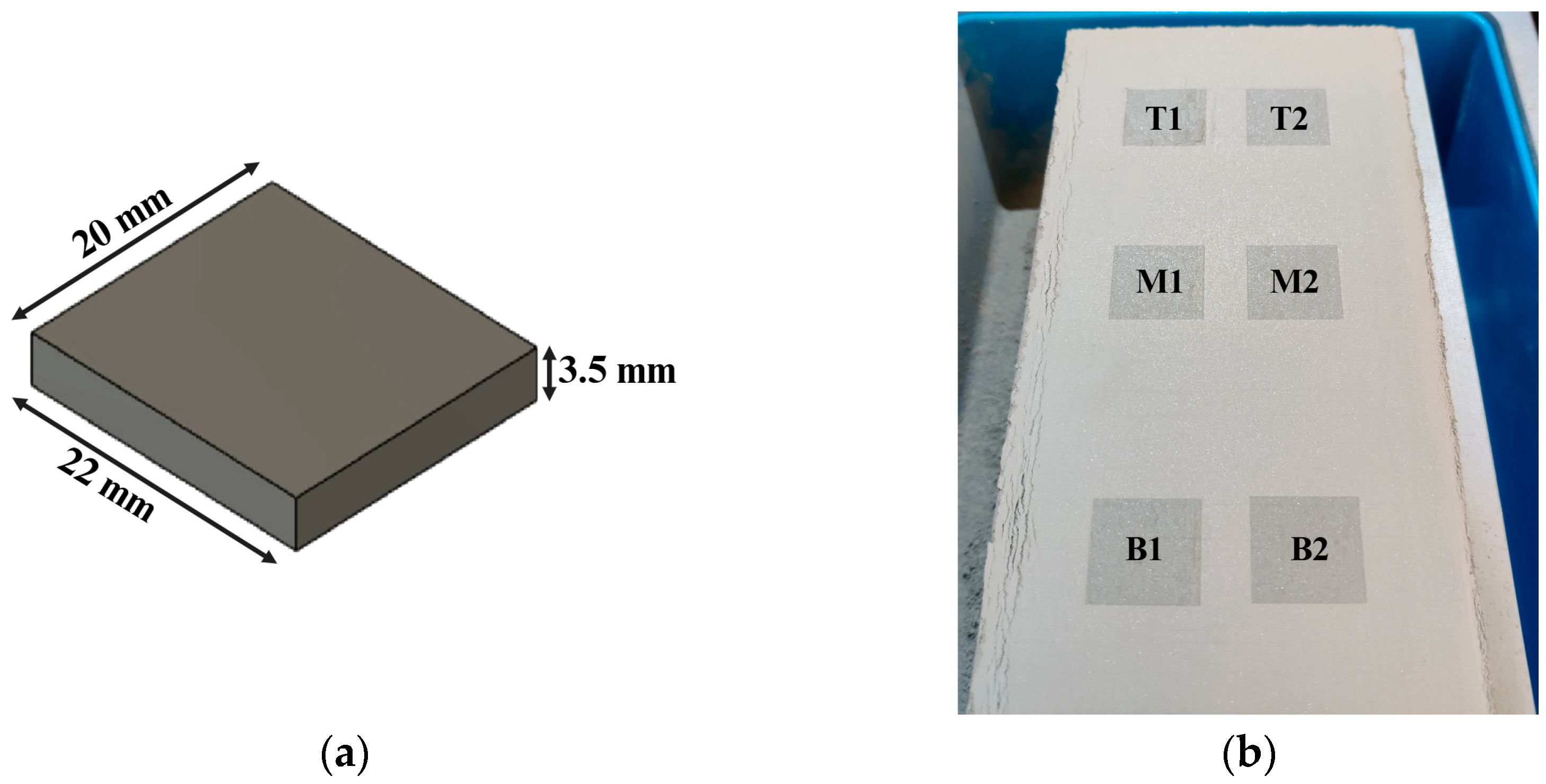
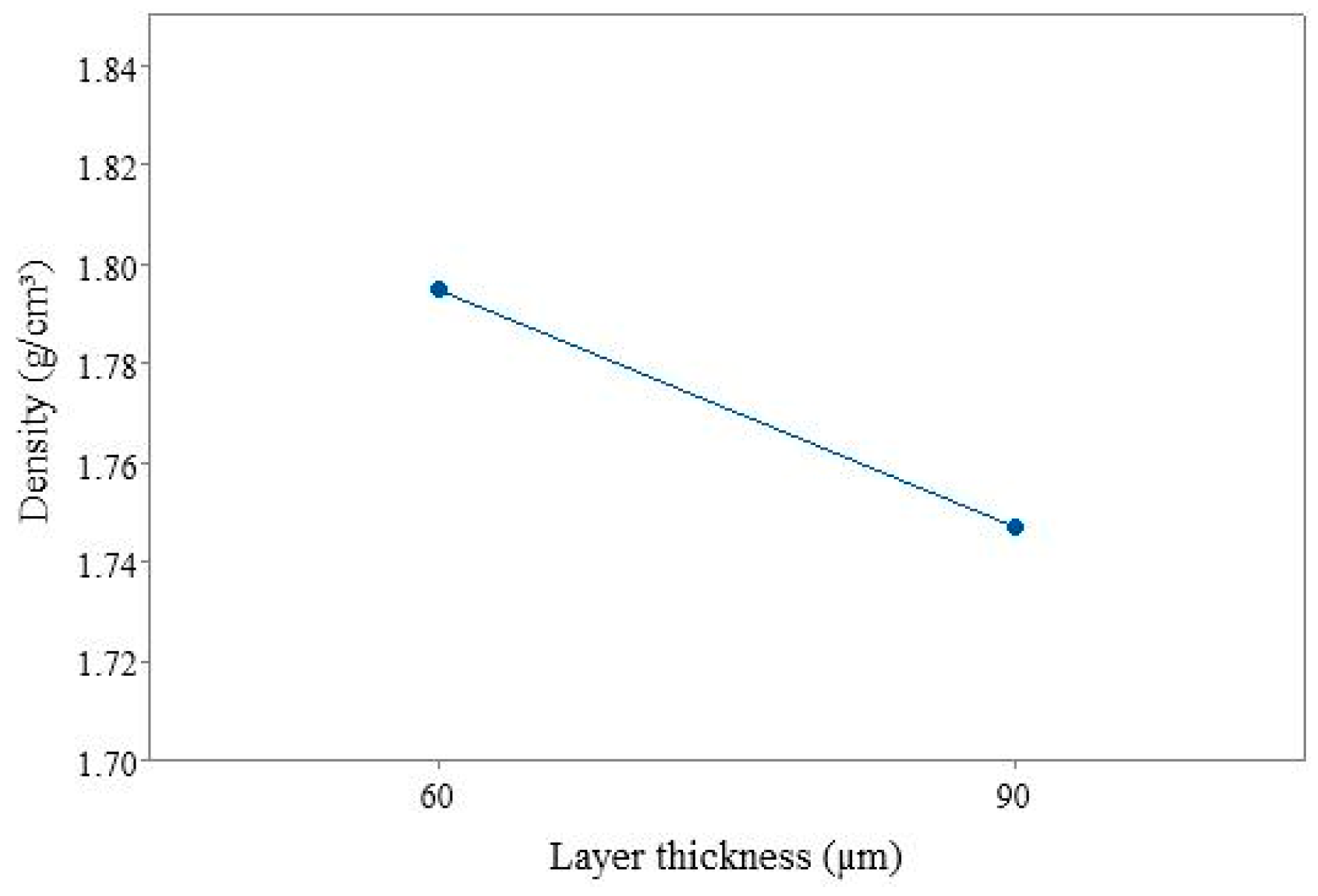
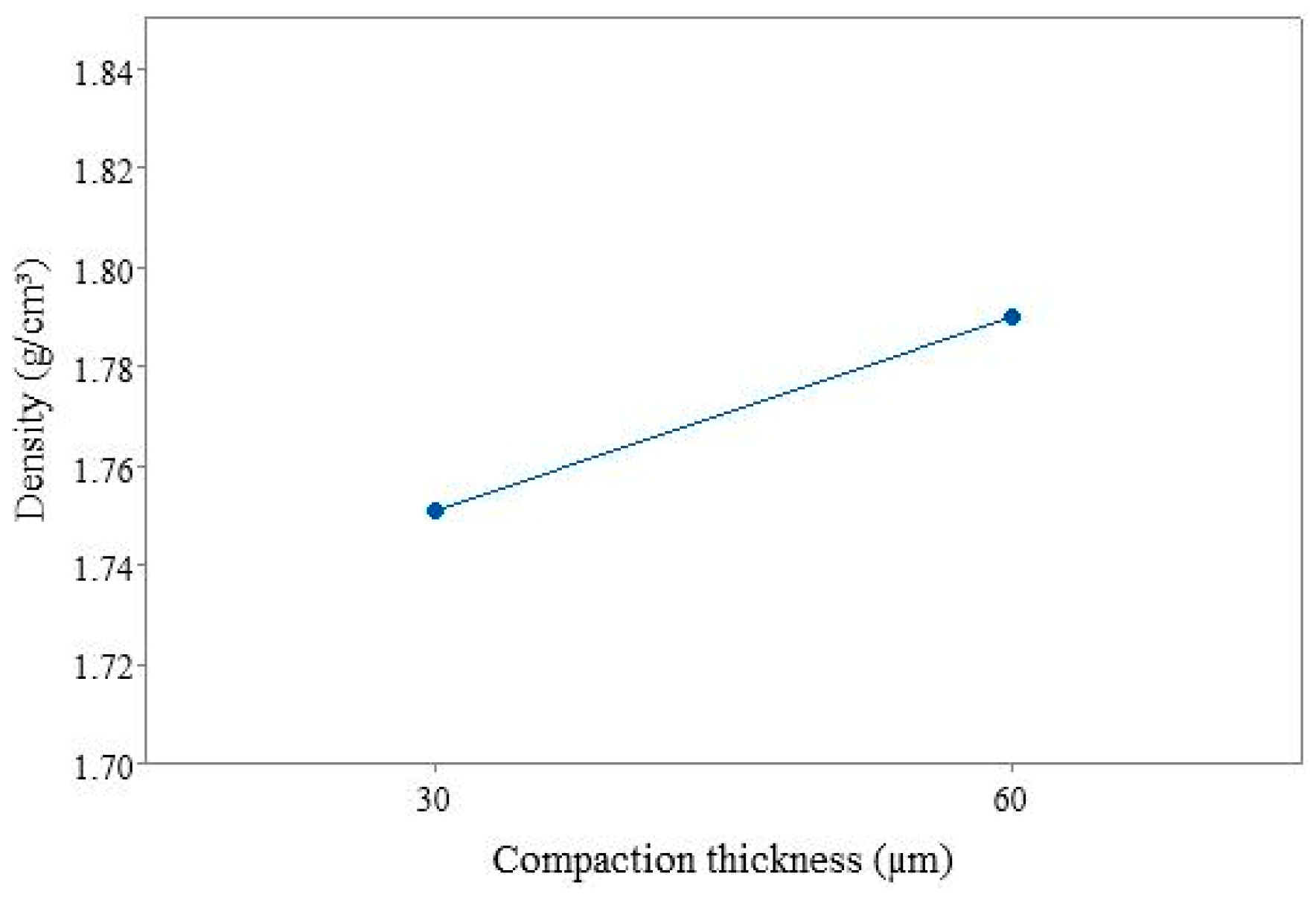
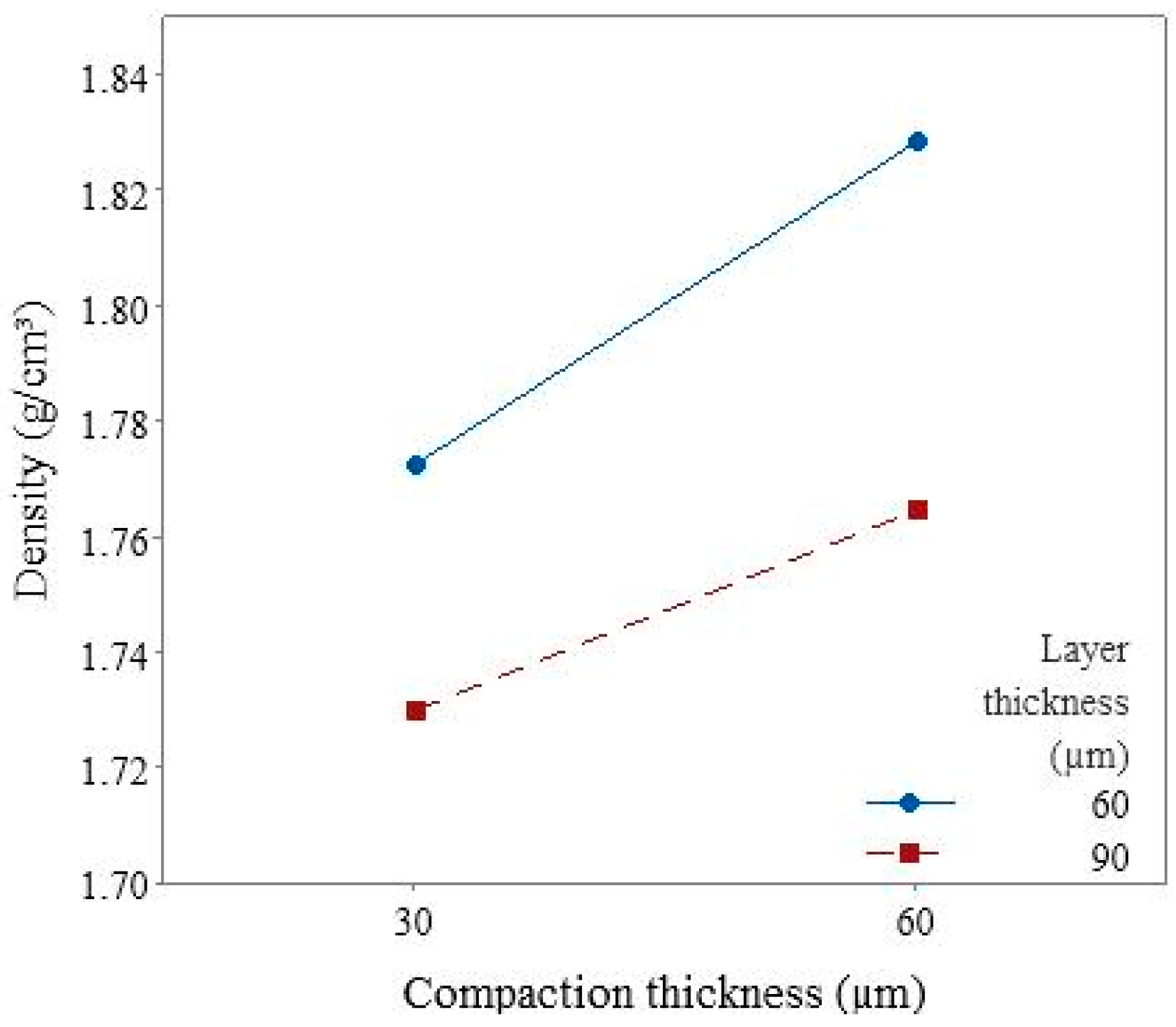
| Variables | Experimental Design | Material | Particle Size (μm) | Reference |
|---|---|---|---|---|
| Layer thickness and binder saturation | 4 experimental runs | Stainless steel 316L | 2.1–7.8 | [17] |
| Layer thickness, roller diameter, supply-to-spread ratio, and translational and rotational roller speeds | Fractional factorial design, 12 experimental runs | Stainless steel 316L | 5.1–20.1 | [18] |
| Layer thickness, binder saturation, and roller traverse speed | 14 experimental runs | Stainless steel 316L | 24–50 | [16] |
| Layer thickness, recoat speed, oscillator speed, roller speed, drying time, and saturation level | Fractional factorial design, 18 experimental runs | Aluminum oxide | 20–40 | [20] |
| Roller actuation, layer thickness, and binder saturation | 12 experimental runs | Iron powder | <45 | [31] |
| Printing Variable | Value |
|---|---|
| Ultrasonic intensity (%) | 100 |
| Roller traverse speed during spreading (mm/s) | 15 |
| Roller traverse speed during compaction (mm/s) | 5 |
| Roller rotation speed during spreading (rpm) | 300 |
| Binder saturation (%) | 36.6 |
| Binder set time (s) | 30 |
| Bed temperature (°C) | 50 |
| Drying time (s) | 15 |
| Packing rate (%) | 48 |
| Variable | Low Level (−) | High Level (+) |
|---|---|---|
| Layer thickness (µm) | 60 | 90 |
| Compaction thickness (µm) | 30 | 60 |
| Experimental Order | Layer Thickness | Compaction Thickness |
|---|---|---|
| 3 | − | + |
| 2 | + | − |
| 1 | − | − |
| 4 | + | + |
| 5 | − | − |
| 7 | − | + |
| 9 | − | - |
| 11 | − | + |
| 6 | + | − |
| 8 | + | + |
| 10 | + | − |
| 12 | + | + |
| Source of Variance | Degree of Freedom | Sum of Squares | F-Value | p-Value |
|---|---|---|---|---|
| Model | 3 | 0.011756 | 4.29 | 0.051 |
| Linear | 2 | 0.011755 | 6.43 | 0.026 |
| Layer thickness (LT) | 1 | 0.007564 | 8.28 | 0.024 |
| Compaction thickness (CT) | 1 | 0.005475 | 5.99 | 0.044 |
| LT × CT | 1 | 0.000303 | 0.33 | 0.583 |
| Residuals | 7 | 0.006395 |
Disclaimer/Publisher’s Note: The statements, opinions and data contained in all publications are solely those of the individual author(s) and contributor(s) and not of MDPI and/or the editor(s). MDPI and/or the editor(s) disclaim responsibility for any injury to people or property resulting from any ideas, methods, instructions or products referred to in the content. |
© 2024 by the authors. Licensee MDPI, Basel, Switzerland. This article is an open access article distributed under the terms and conditions of the Creative Commons Attribution (CC BY) license (https://creativecommons.org/licenses/by/4.0/).
Share and Cite
Pasha, M.M.; Arman, M.S.; Khan, F.; Pei, Z.; Kachur, S. Effects of Layer Thickness and Compaction Thickness on Green Part Density in Binder Jetting Additive Manufacturing of Silicon Carbide: Designed Experiments. J. Manuf. Mater. Process. 2024, 8, 148. https://doi.org/10.3390/jmmp8040148
Pasha MM, Arman MS, Khan F, Pei Z, Kachur S. Effects of Layer Thickness and Compaction Thickness on Green Part Density in Binder Jetting Additive Manufacturing of Silicon Carbide: Designed Experiments. Journal of Manufacturing and Materials Processing. 2024; 8(4):148. https://doi.org/10.3390/jmmp8040148
Chicago/Turabian StylePasha, Mostafa Meraj, Md Shakil Arman, Fahim Khan, Zhijian Pei, and Stephen Kachur. 2024. "Effects of Layer Thickness and Compaction Thickness on Green Part Density in Binder Jetting Additive Manufacturing of Silicon Carbide: Designed Experiments" Journal of Manufacturing and Materials Processing 8, no. 4: 148. https://doi.org/10.3390/jmmp8040148
APA StylePasha, M. M., Arman, M. S., Khan, F., Pei, Z., & Kachur, S. (2024). Effects of Layer Thickness and Compaction Thickness on Green Part Density in Binder Jetting Additive Manufacturing of Silicon Carbide: Designed Experiments. Journal of Manufacturing and Materials Processing, 8(4), 148. https://doi.org/10.3390/jmmp8040148







